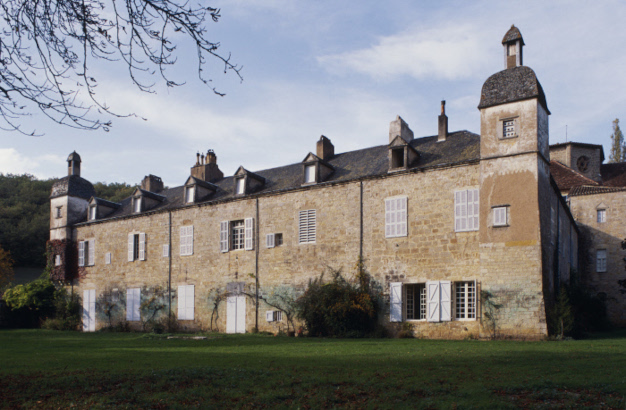
Founded in 1144 in the valley of the Seye, by the bishop of Rodez, the abbey Notre-Dame de Beaulieu offers the characteristics of the Cistercian architecture and houses a superb contemporary art center..
A little history...
The community of Beaulieu was founded in the 12th century. It is attested in 1151 by a document mentioning a gift of land to the monks, the first monks being probably hermits who joined the Cistercian order in a second time.
The Gothic cloister was destroyed by the Protestants during the Wars of Religion (1562 - 1598). The monks then abandoned the abbey for about ten years, from 1592 to the beginning of the 17th century.
The French Revolution marked the definitive end of the monastic occupation of the abbey of Beaulieu-en-Rouergue which was sold as a national asset to a former captain of the merchant navy who became a justice of the peace in Saint Antonin, Joseph Perret, who bequeathed the domain to the municipality of Saint Antonin Noble Val.
In 1842, the municipality of Saint Antonin plans to equip its town with a new church. Thus, the architect Eugène Viollet-le-Duc proposed to lay the abbey church of Beaulieu stone by stone to rebuild it in the village. In spite of Prosper Mérimée's opposition, the translation begins in 1844, the roof and then the framework of the nave are dismantled...
But the project was too expensive! To finance it, the domain was sold to Auguste Coste in 1845. But this was not enough and the project was definitively stopped and the church was also sold to Costes in 1872 who transformed the property into an agricultural estate.
It is thus in an advanced state of dilapidation that Geneviève Bonnefoi and Pierre Brache discover the abbey in 1953. After the purchase in 1960, it took them 10 years to save it from ruin!
Their collection of contemporary artworks has guided the current cultural life of the monument.
A quality gothic architecture
In the cellar or the chapter house, the Gothic style is primitive, the ribbed vaults are squat. As for those of the church, the system is similar but they are more slender, characteristic of the southern Gothic style. The building is remarkable for its sobriety and clarity, two principles that were essential to Cistercian monks.
The Cistercian engineering for the control of natural resources, in particular water, is astonishing. The canalization of the river, the fishponds and the many networks that feed them remain.
In the conventual buildings, we discover painted decorations of the 17th century, some recently discovered and restored, in particular those of the sacristy where the lapidary background (the cut stones, decorated) found during archaeological excavations will be exposed.
One room of the new tour deals with the ancient history of the abbey. Equipped with screens and interactive devices, this space allows visitors to understand the spread of the Cistercian order throughout Europe and the establishment of the monastic community in the Seye valley.
A collection of modern art...
The museum tour allows visitors to meet the couple of patrons, Geneviève Bonnefoi and Pierre Brache, their history, and their incredible art collection.
The collection began in 1948 with the purchase of two watercolors by Henri Michaux and grew considerably in the 1950s and 60s.
In 1973 the couple separated but, to ensure the continuity of their project, they bequeathed the abbey and part of their art collection to the Centre des Monuments Nationaux. When Pierre Brache died in 1999, he bequeathed his personal collection to his ex-wife, Geneviève Bonnefoi, who in turn donated the entire collection of nearly 1300 works to the Centre des Monuments Nationaux upon her death in 2018.
Over the past three years, the Centre des Monuments Nationaux has carried out major restoration and development work to present part of this rich collection in the abbey. Reopened to the public last June, the abbey of Beaulieu-en-Rouergue is now an important place for contemporary art in Tarn-et-Garonne.
The collection is presented in thematic rooms (gestural painting, matierist, nuagist) or monographic (Jean Dubuffet, Simon Hantaï or Henri Michaux).
A device, available at the reception desk, will allow young visitors to select the works they prefer and to imagine their own virtual exhibition in the church.
And natural spaces...
To complete the discovery of Beaulieu Abbey, one must stroll through the gardens. Large trees are the witnesses of a landscaped park planted in the 19th century. With various species: a cedar of Lebanon, a catalpa, or the superb magnolia, under which in summer, is installed the terrace of the tea room. To the south, you will love the garden created according to the principles of André Eve and planted with a thousand rosebushes, accompanied by perennials that offer a colorful show throughout the year.
Abbey of Beaulieu-en-Rouergue
82330 Ginals
Tel : 05 63 24 50 10
abbaye.beaulieu@monuments-nationaux.fr
https://www.beaulieu-en-rouergue.fr/
Translated with www.DeepL.com/Translator
(free version)




